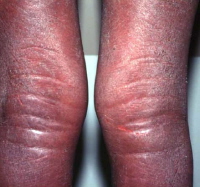[su_divider top=”no” style=”double” divider_color=”#952524″ link_color=”#952524″ size=”2″ margin=”10″]
What is Eosinophilia? How to manage it? What are the precautions to be taken? What are the signs and symptoms? What is the cause of this disease? How to treat it? How can homeopathy help you? All of this answered, in this post and of course our doctors always there to help you. Just fill in your details in the form down below and we will answer all your questions for FREE!
[su_divider top=”no” style=”double” divider_color=”#952524″ link_color=”#952524″ size=”2″ margin=”10″]
[sc name=”query”]

What is eosinophilia?
Eosinophilia is a condition in which the eosinophil cells count exceeds the normal limit that is 0.45×109 in the peripheral blood. Eosinophils are one of the five major types of disease-fighting white blood cells.
Eosinophils circulate in the blood when their levels are high but high eosinophil concentrations may also occur at the site of an infection or inflammation. Eosinophils are the type of white blood cell. They contain particles which are filled with chemicals that help to fight the infection and play a major role in the immune mechanism of the body.
In normal conditions of body, eosinophils don’t have a large number. The body produces more of the eosinophils in response to some infections, allergic disorder, inflammation of the skin and parasitic infections or in case of some bone marrow disorders. There are some conditions in which eosinophils move outside the bloodstream and enter the other organs and tissues. Term eosinophilia is also defined as the increase of eosinophilic leukocytes in peripheral blood to more than 600 cells per microliter (µL) of blood. If the count of eosinophils in the peripheral blood is more than 1500 cells per microlitre and when this condition last for many months then it is termed as a hypereosinophilic syndrome.
There are two major roles of eosinophil in the immune system and they are as follows: Destruction of foreign substances
Eosinophils can engulf foreign substances and they engulf substances related to infection due to a parasite.
Inflammation regulation: Eosinophils help to promote inflammation and thereby plays a very important and useful role in controlling the disease site.
What are the causes of eosinophilia?
There are specific diseases and conditions which are responsible for the rise of eosinophil number in the blood and that are as follows:-
• Asthma.
• Ascariasis.
• Atopic dermatitis.
• Crohn’s disease.
• Eosinophilic leukemia.
• Lupus.
• Lymphatic filariasis.
• Non-Hodgkin’s lymphoma.
• Ovarian cancer
• Scarlet fever
• Chronic myelogenous leukemia
• Churg-strauss syndrome.
• Drug allergy.
• Hay fever.
• Hodgkin’s lymphoma
• Trichinosis
• Ulcerative colitis
• Cholesterol embolism.
• Coccidioidomycosis.
• Interstitial nephropathy
• Ulcerative colitis.
• Primary immunodeficiency
• Parasitic infections such as Ascariasis Trichinosis.
• Schistosomiasis.
• Fascioliasis, Paragonimiasis.
• Visceral larva migrans.
• Strongyloidiasis.
• Gnasthostomiasis.
• Neoplasia Human T-cell lymphotropic virus (HTLV-1).
• Adult T-cell leukemia.
• Gastric and lung carcinoma.
What are the symptoms of eosinophilia?
Symptoms of eosinophilia are usually that of the underlying cause-
• Eosinophilia due to asthma is marked by following symptoms such as shortness of breath, wheezing.
• In cases of parasitic infections the symptoms that are associated are as follows pain in the abdomen, diarrhea, fever, cough or rashes.
• When eosinophilia rise due to allergic reaction then symptoms are associated are rashes, itching.
• Rare symptoms associated with eosinophilia are weight loss, night sweats, lymph nodes enlargement, skin rashes, and sensation of numbness and tingling.
Is eosinophilia curable?
Treatment is directed toward the cause behind this problem. However, in primary eosinophilia, or if the eosinophil count is reduced, corticosteroids such as prednisone may be used. However, immune suppression, the mechanism of action of corticosteroids, can be fatal in patients with condition of parasitosis.
Do high eosinophils mean cancer?
Elevated eosinophil levels may occur in rare blood cancers. Eosinophils are white blood cells that help to fight parasitic infections. Elevated levels of eosinophil also can occur in certain allergic diseases, autoimmune diseases, and cancer.
Can food allergies cause high eosinophils?
Presence of large number of eosinophils in the esophagus may result from a food allergy reaction, acid reflux or airborne allergens, which can contribute to inflammation, or injury to the esophageal tissue. However, seasonal variation in patients with food induced EoE can be seen as high as 25 percent of the patients.
What is treatment for eosinophilia?
Treatment depends upon the cause involved in producing the condition of eosinophilia. The medications that are helpful in lowering the eosinophilic levels are as follows
• Corticosteroids such as prednisone are used. Surgeries for tumors is conducted depending upon the site of the tumor.
For more information, you can visit WebMD and eMedicine.
Eosinophilia
[su_divider divider_color=”#952524″ link_color=”#952524″ size=”2″ margin=”10″]
[sc name=”know-your-doctor”]
[sc name=”more-links-diseases”]

